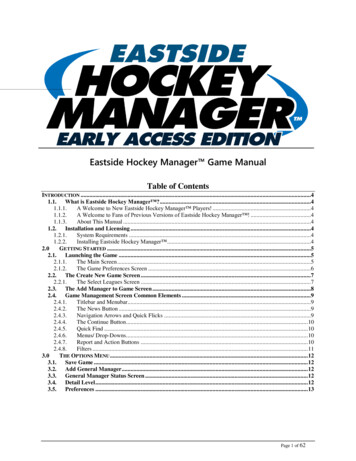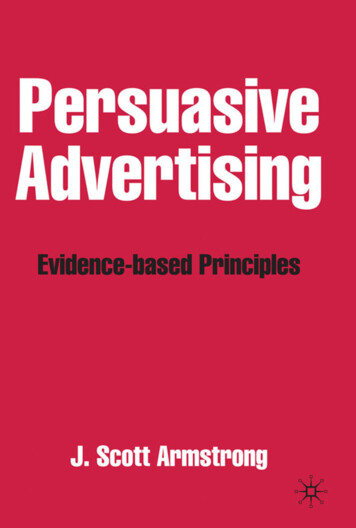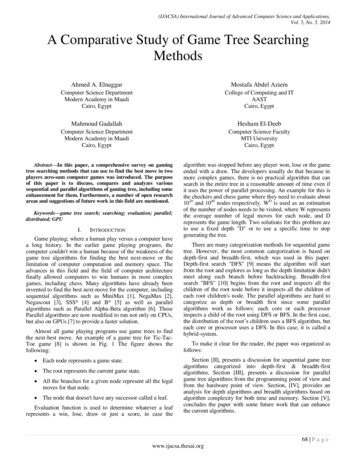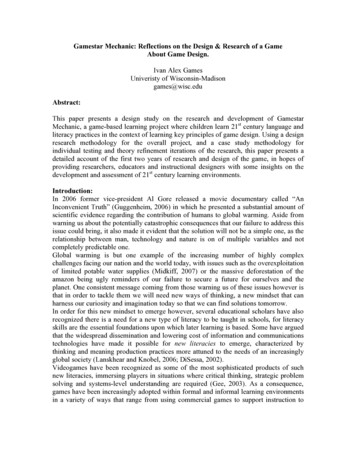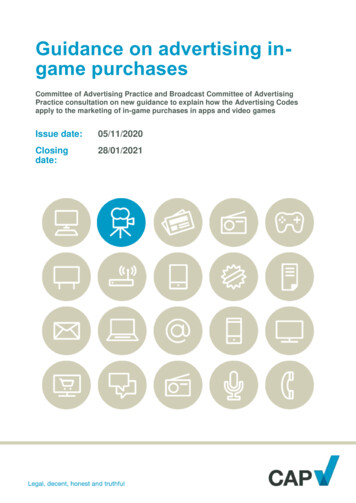
Transcription
Guidance on advertising ingame purchasesCommittee of Advertising Practice and Broadcast Committee of AdvertisingPractice consultation on new guidance to explain how the Advertising Codesapply to the marketing of in-game purchases in apps and video gamesIssue date:05/11/2020Closingdate:28/01/2021
Contents1. Executive summary . 32. Introduction to UK advertising regulation . 43. Regulatory framework of the BCAP Code . 64. Proposals. 75. Background . 86. Consultation question . 157. How to respond and next steps . 16Contact us . 17
1. Executive summaryThe Committee of Advertising Practice (CAP), author of the UK Code of Nonbroadcast Advertising and Direct & Promotional Marketing (CAP Code) and theBroadcast Committee of Advertising Practice (BCAP), author of the UK Code ofBroadcast Advertising (BCAP Code) are consulting on proposals to introduce newformal guidance on advertising in-game purchases.CAP and BCAP understand that concerns have been raised by the public, the video gamepress, campaign and research organisations, and by Government Select Committees aboutelements of in-game purchasing. Although some of these concerns fall outside of the scopeof advertising regulation, CAP and BCAP have identified three areas in which formalguidance may help to mitigate the potential harms identified by concerned parties. Theseareas are: Clarity of information at point of purchaseResponsibility of advertising messagesTruthfulness in advertising of games containing purchasingRather than implementing new rules, CAP and BCAP consider that the issues in questioncan be suitably addressed through specific formal guidance on existing rules.Point of purchaseCAP and BCAP are concerned that a combination of factors that vary the value of in-gameitems may have a serious impact on the ability of consumers (particularly children orvulnerable people) to understand how much real-world money they are spending on ingame items. The proposed guidance will advise marketers on how they should presentinformation to consumers in a way that will support their ability to determine how muchitems will really cost them.Advertising messagesThe nature of in-game purchases, especially random-item purchasing (often called ‘lootboxes’), has the potential to cause harm, particularly to vulnerable consumers. Appropriateregulatory intervention on the part of vulnerable people for riskier product categories is ageneral principle well-established in the Codes. The proposed guidance seeks to do this byensuring that messaging around the purchase of in-game items (especially random-itempurchasing) reduces the risk of harm to vulnerable people.Advertising games with in-game purchasesAs well as marketing of in-game purchases, CAP and BCAP have concerns about theadvertising of games that contain these mechanisms and whether it makes clear that somecontent featured in the ad may be subject to an additional cost. The proposed guidanceoffers advice on making clear that in-game purchasing is available, and how to ensurefeaturing purchased content in game ads is unlikely to mislead.This consultation presents the proposed guidance for comment, with this documentexplaining the background to each section.The consultation will close at 5pm on 28 January 2021. For more information on howto respond, please see section 7.Guidance on advertising in-game purchases3
2. Introduction to UK advertising regulation2.1 The Committee of Advertising Practice (CAP)CAP is the self-regulatory body that creates, revises and enforces the UK Code of Nonbroadcast Advertising and Direct & Promotional Marketing (the CAP Code). The CAP Codecovers non-broadcast marketing communications, which include those placed in traditionaland new media, promotional marketing, direct marketing communications and marketingcommunications on marketers’ own websites. The marketer has primary responsibility forcomplying with the CAP Code and their ads must comply with it. Ads that are judged not tocomply with the Code must be withdrawn or amended. Parties that do not comply with theCAP Code could be subject to adverse publicity, resulting from rulings by the AdvertisingStandards Authority (ASA), or further sanctions including the denial of media space.CAP’s members include organisations that represent advertising, promotional and directmarketing and media businesses. Through their membership of CAP memberorganisations, or through contractual agreements with media publishers and carriers, thoseorganisations agree to comply with the Code so that marketing communications are legal,decent, honest and truthful, and consumer confidence is maintained.By practising self-regulation, the marketing community ensures the integrity of advertising,promotions and direct marketing. The value of self-regulation as an alternative to statutorycontrol is recognised in EC Directives, including Directive 2005/29/EC (on unfair business toconsumer commercial practices). Self-regulation is accepted by the Department forBusiness, Energy and Industrial Strategy and the courts as a first line of control inprotecting consumers and the industry.Further information about CAP is available at www.cap.org.uk.2.2 The Broadcast Committee of Advertising Practice (BCAP)BCAP is the regulatory body responsible for maintaining the UK Code of BroadcastAdvertising (the BCAP Code) under agreement with the Office of Communications (Ofcom).Ofcom has a statutory duty, under the Communications Act 2003, to maintain standards inTV and radio advertisements. In 2004, Ofcom entrusted BCAP and the broadcast arm ofthe ASA with the regulation of broadcast advertisements in recognition of CAP and theASA’s successful regulation of non-broadcast marketing for over 40 years, and in line withbetter regulation principles.The BCAP Code regulates all advertisements on television channels and radio stationslicensed by Ofcom and all advertisements on Sianel Pedwar Cymru (S4C) and S4C digital,including teleshopping channels and any additional television service (including televisiontext services and interactive television services). The BCAP Code is enforced againstOfcom-licensed broadcasters, Sianel Pedwar Cymru (S4C) and S4C digital. Broadcastersare required by the terms of their Ofcom licence, and, for S4C, by statute, to adhere to thestandards set out in the BCAP Code.BCAP members include broadcasters and trade associations representing advertisers,broadcasters and agencies. BCAP must seek advice on proposed Code changes from anexpert consumer panel, the Advertising Advisory Committee (AAC). Under Section 324 ofthe Communications Act 2003, BCAP must consult on proposed Code changes. BCAPstrives to ensure that its rule-making is transparent, accountable, proportionate, consistentGuidance on advertising in-game purchases4
and targeted where action is needed, in accordance with the Communications Act 2003.Ofcom must approve Code changes before BCAP implements them.Further information about BCAP and the AAC is available at www.cap.org.uk.2.3 The Advertising Standards Authority (ASA)The ASA is the independent body responsible for administering the CAP and BCAP Codesand ensuring that the self-regulatory system works in the public interest. The Codes requirethat all advertising is legal, decent, honest and truthful.The ASA assesses complaints from the public and industry. Decisions on investigatedcomplaints are taken by the independent ASA Council. The ASA Council’s rulings arepublished on the ASA’s website and made available to the media. If the ASA Councilupholds a complaint about an ad, it must be withdrawn or amended.An Independent Review Procedure exists for interested parties who are dissatisfied with theoutcome of a case. CAP conducts compliance, monitoring and research to help enforce theASA Council’s decisions. Information about the ASA is available at www.asa.org.uk.2.4 FundingThe entire system is funded by a levy on the cost of advertising space, administered by theAdvertising Standards Board of Finance (Asbof) and the Broadcast Advertising StandardsBoard of Finance (Basbof). Both finance boards operate independently of the ASA toensure there is no question of funding affecting the ASA’s decision-making.Information about Asbof and Basbof is available at www.asbof.co.uk andwww.basbof.co.uk.Guidance on advertising in-game purchases5
3. Regulatory framework of the BCAP Code3.1 Communications Act 2003The Communications Act 2003 (the Act) sets out provisions for the regulation ofbroadcasting and television and radio services, including provisions aimed at securingstandards for broadcast advertisements. The most relevant standards objective to thisconsultation is:319(2)(h) that the inclusion of advertising which may be misleading, harmful oroffensive in television and radio services is prevented.The Act requires Ofcom to set and, from time to time, review and revise, a Code containingstandards for the content of broadcast advertisements carried by TV and radio serviceslicensed under the Broadcasting Acts 1990 and 1996. Ofcom has contracted out the settingof advertising standards to BCAP under the Contracting Out (Functions Relating toBroadcast Advertising) and Specification of Relevant Functions Order 2004. That function isexercised in consultation with and agreement of Ofcom.Guidance on advertising in-game purchases6
4. ProposalsCAP and BCAP understand that concerns have been raised by the public, the video gamepress, campaign and research organisations, and by Government Select Committees aboutthe potential for in-game purchasing, particularly of random-item products (often called ‘lootboxes’), to cause harm and/or to mislead consumers. As discussed below, the majority ofthese concerns relate to the products themselves and are, therefore, in the jurisdiction oforganisations other than the ASA/CAP/BCAP, such as the Competition and MarketsAuthority or the Gambling Commission. However, CAP and BCAP consider that some ofthe issues raised by concerned parties do involve marketing and that there is scope forregulatory action in the following areas: Clarity of information at point of purchaseResponsibility of advertising messagesTruthfulness in advertising of games containing purchasingThe Advertising Codes already contain prohibitions on harmful and misleading advertising,and on this occasion CAP and BCAP do not consider that further rules are necessary toaddress these specific issues in the interactive entertainment sector. Instead, they proposethe publication of a formal piece of Advertising Guidance, which explains to advertisers howthe existing Codes apply to this specific matter, i.e. what responsible and truthful marketinglooks like for in-game purchasing.The draft guidance is attached as an annex to this document.
5. Background5.1 DefinitionsIn-game purchasingWithin modern video games and apps, it is common to be able to make purchases withinthe game, whether directly or through an external platform (such as Steam, Google Play, orOrigin). These purchases may range from very small and low value, such as an item thatboosts performance or skips waiting times, to relatively large and high value, such as anexpansion pack or bundle of currency. For the avoidance of doubt, in-game/app storefrontsthat offer digital products for sale are within the scope of the CAP Code.Proprietary and premium currencyIt is very common for games to use a proprietary currency (with names such as credits,gems, or gold), with which the player can obtain additional game resources. For somegames, this currency can only be earned within the game, and for others either the currencyor (less commonly) the resources themselves can be purchased with real-world money.Games that use in-game purchasing frequently have two levels of proprietary currency.One, which can be earned with relative ease in-game, will be a basic currency that allowsplayers to purchase ordinary game items or resources and play a somewhat limited versionof the game. The ‘premium’ currency is more difficult to earn or, sometimes, not possible toearn at all through gameplay and only available to purchase with real money. This currencyis then exchanged in-game for higher-value products, such as prestige cosmetic upgradesor more powerful items. It is common for small amounts of premium currency to be ‘earned’through watching video ads.Alongside these basic game economic mechanics, the premium currency may be used topurchase random-item products (see below). In some cases, it is the only way to buy theseproducts. Where proprietary currency is required to purchase in-game items, it is usually ina separate part of the game storefront, meaning that players do not see the value of thecurrency next to the amount to be paid for an item.Random-item purchases (‘loot boxes’)Random-item purchases function similarly to a lucky dip – the player pays for a chance toopen a virtual box, and receives a number of digital items with varying in-game values.Players know that they will receive a certain number of items, but not what they will be orhow rare/valuable they are. Some items are less likely to be received and are considered‘rare’, while others may be received frequently. It is common for random-item purchases tobe bought with premium proprietary currency and sold in ‘multipacks’ of varying value.Some games show players what items are inside a random-item purchase, and some mayshow the odds of receiving various rarity levels.Odd-pricingIn addition, both currency and loot boxes may be subject to ‘odd-pricing’ – this is whereboth purchases are only available in specific increments, which do not match up andtherefore leave the player with too much or little proprietary currency. For example, you mayonly be able to buy currency in increments of 50, but each loot box might cost 30. For theplayer to redeem all of their currency with nothing left over, they would have to buy 150
credits and redeem for 5 loot boxes; it is not possible to buy a single box with the rightamount of currency.Moreover, many games ‘bundle’ currency and loot boxes, so the more you buy the morecost-effective they are. For instance, 50 credits might cost 5, but 500 credits could cost 40.Cosmetic/functional itemsSome digital items only affect the aesthetic of a character or scene within a game – such ascostumes, signature voice lines, or different looking equipment. These are termed‘cosmetic’ items and are often referred to as ‘skins’. Although they do not affect gameplay,they may be valuable to players if they are known to be rare, limited edition, or if they holdsignificant aesthetic value to a player.Other items give players an edge in gameplay – more powerful weapons, extra lives orchances to retry a puzzle, or extra resources for use in-game. These are functional itemsand hold value for the advantage or assistance they give a player. Games featuring theseitems, particularly when they are available to buy with real money, are sometimes referredto as ‘pay to win’ because the advantage given by the items can outweigh any particularskill.Battle pass/season passPasses are virtual purchases that allow a player time-limited access to another aspect ofgame than just the standard version. For instance, the player might purchase access to aspecific part of the gameworld, be entitled to take part in tournaments, or collect passspecific items.Downloadable content (DLC)As well as the base game, video games may also feature expansion packs or DLC. Theseare significant extra parts that players can purchase and download, such as newcharacters, ‘maps’ (a new part of the gameworld), or even a whole new style to play in.5.2 Activity by other regulatory organisationsGambling CommissionOne of the chief concerns raised over the last few years has been that random-itempurchasing functions (‘loot boxes’) as a form of gambling. There have been calls for theGambling Commission to intervene in this area, and the Commission therefore consideredwhether random-item purchasing fell within the legal definition of gambling (and thus withintheir scope), concluding that:In practical terms where in-game items obtained via loot boxes are confined foruse within the game and cannot be cashed out it is unlikely to be caught as alicensable gambling ideo-gamesGuidance on advertising in-game purchases9
In the same statement, the Commission noted that the public are not necessarilyspecifically concerned with whether these items are defined as gambling, but whether theyhave the potential to cause harm to children.Not all random-item purchases are, however, confined to the game and unable to be cashedout. The Commission notes that these may be considered differently:Where there are readily accessible opportunities to cash in or exchange thoseawarded in-game items for money or money’s worth those elements of the gameare likely to be considered licensable gambling activities. 2Purchases caught by gambling legislation in this way would be subject to the same regulationand enforcement as more common forms of gambling, including their marketingcommunications falling under the gambling rules of the CAP and BCAP Codes.Department for Digital, Culture, Media and SportIn June 2020, the Government responded to a report by the DCMS Select Committee,which called for further regulation of random-item purchasing as part of their report onImmersive and Addictive Technologies. One of the recommendations of this report was “tospecify that loot boxes are a game of chance”3 covered by the Gambling Act 2005 (andtherefore under the scope of the Gambling Commission). In response, the Governmentstated[we] announced in the Queen’s Speech in December 2019 our intention to carry outa review of the Gambling Act 2005, with a particular focus on tackling issues aroundloot boxes To support this review of the Gambling Act 2005 and our widerprogramme of research about video games, and to ensure government policy isbased on a sound understanding of the issue and its place in the wider policyframework, the government will be launching a call for evidence on loot boxes The results from the call for evidence will be considered alongside the review of theGambling Act 20054This call for evidence, aimed at players and at industry, launched in September 2020and is intended to gather evidence and understand the impact of loot boxes. At the timeof publishing this consultation, the call for evidence is still open.5Other organisations, including the Royal Society for Public Health and the Children’sCommissioner, have also raised concerns that are reflected in the above response.The role of advertising regulationThe majority of concerns raised in relation to in-game purchasing concern the nature ofrandom-item purchasing. As noted above, a primary issue is that these are often perceivedto be so similar to ‘game of chance’ gambling as to prompt calls for their regulation undergambling legislation. However, the Gambling Commission’s analysis has determined ing4 ibid5 oxes-in-video-games-call-for-evidence3Guidance on advertising in-game purchases10
many types of random-item purchasing do not fall within this definition, and we understandthat these are by far the most common types of purchase.The question of whether these products should be defined as gambling and banned eitherfrom sale or advertising is a question of law, and falls outside of the scope of CAP andBCAP regulation. However, CAP and BCAP nonetheless recognise that there are mattersclosely related to this central issue that do concern advertising and which could beaddressed as part of the wider regulatory framework: Clarity of information at point of purchaseResponsibility of advertising messagesTruthfulness in advertising of games containing purchasingTo this end, CAP and BCAP have considered the extent to which advertising in these areascould pose a risk of harm or other consumer detriment, and what regulatory action would bemost appropriate to mitigate any such risks.While many random-item purchases are not defined as gambling, and those are the subjectof this consultation, any that are would be subject to the gambling rules in the CAP andBCAP Codes.5.3 Concerns about the advertising of in-game purchasingProprietary currency, bundling, and ‘odd-pricing’As noted above, in-game purchases may be required to be made with a proprietarycurrency and either or both of the currency or the item may be odd-priced and/or bundled.When all these factors are combined, it may be challenging for a consumer to intuitivelyunderstand how much they are spending on an individual item. The varying levels ofbundling and cost-effectiveness add an additional layer of challenge. The ASA’s previouswork on broadband pricing6 found that, even where all the information required is includedin the ad, consumers are not always willing or able to work out the overall price of a productwhen the terms are not straightforward. In some examples of in-game purchasing, aconsumer must remember the cost of the currency and work out how much each credit wasworth, multiply this by the number of credits for the bundle of items, and (where relevant)divide by the size of the bundle and type of items included. For random-item purchases,they must also factor in the probability that they receive an item that holds value for them.In terms of consumer spending behaviour, a report commissioned by the EuropeanParliament7 considered the academic research on and related to loot boxes and concludedthat consumers were more likely to spend more money when using proprietary currency(such as casino chips) because it makes the transaction less tangible. Consumers are alsolikely to spend more money than they intended, but gain less overall value, when presentedwith bundles. These outcomes are indications that consumers may not be in a position tounderstand fully the amount of money they are spending.CAP and BCAP are therefore concerned that the combination of proprietary currency,bundling, and odd-pricing may have a serious impact on the ability of 2727/IPOL STU(2020)652727 EN.pdfGuidance on advertising in-game purchases11
(particularly children or vulnerable people) to understand how much real-world money theyare spending on in-game items. Under the Advertising Codes, where an ad quotes a pricefor a product, the inclusive price of the product (or how it is calculated) is materialinformation to a consumer’s transactional decision.8 Where the price is present butobscured (as explored above), CAP and BCAP consider that this is unlikely to be compliantwith the requirements of the Codes.The proposed guidance, therefore, explains that the real-world prices for in-gamepurchased products should be made clear to consumers in the storefront, considering thefollowing: Whether proprietary currency is usedHow bundling affects priceThe relationship between the cost of currency and the cost of items, where odd-pricingis a relevant issuePresentation of in-game purchasingThere is a variety of ways in which in-game purchases may be presented to consumers,both in and out of the game, with the following examples representing commonapproaches: Pop-up messages with offers of extra lives/boosters etc. when the player losesPop-up messages offering items when certain game aspects are interacted withIn-game storefronts, with or without offersPages on the game’s website announcing new itemsLinks to purchase DLC/passes on the game’s website/hosting platform/in-gameAdvertorial content from streamersWithin these messaging platforms there is also a range of approaches, from a neutralavailability-only style (e.g. in an online storefront) to messaging relating to likelihood ofsuccess (e.g. “try one more time by purchasing this upgrade!”) or social standing. Some ofthese messages may emphasise the functionality of the items, others may focus on the‘rarity’ of particular skins and the exclusivity of owning them. With random-item purchasing,the ads may revolve around the chance of obtaining something particularly rare or useful.While many of these approaches are unlikely to cause harm, CAP and BCAP areconcerned that some types of messaging (particularly when in a time-dependent context)may have the potential to cause harm to some vulnerable individuals. Although there is onlylimited academic research on potential harms from random-item purchasing, one piececited in the above European Parliament report has established a correlative link betweenproblem gambling behaviour and random-item purchase spend:in the Zendle and Cairns (2019) analysis, the average spending on loot boxeswas 11.14 US dollars (approx. 10 Euro) for non-problem gamblers while it was38.24 US dollars (approx. 34 Euro) for problem gamblers. However, the83.4For marketing communications that quote prices for advertised products, material information [for thepurposes of rule 3.3] includes:3.4.3the price of the advertised product, including taxes, or, if the nature of the product is such that the price cannotbe calculated in advance, the manner in which the price is calculatedGuidance on advertising in-game purchases12
researchers are unable to establish whether loot box spending leads to problemgambling, or whether online game players with pre-existing gambling problemsare especially attracted to spending money on loot boxes. They alsoacknowledge that their results have limited generalisability due to the nature ofthe used samples and call for more research to reach robust conclusions.Nevertheless, Zendle and the co-authors believe their results present ajustification for regulating loot boxes, for example by restricting children's accessto them.9Regardless of the direction of this causality, there is a case to be made that there ispotential for harm – either because the loot box spending is causing problematic gamblingbehaviours (which are themselves known to be harmful) or because loot box spending is anexpression of those behaviours. In either instance, irresponsible advertising of loot boxeshas the potential either to cause a quantifiable harm through association with problemgambling or to be preying on those who are susceptible to over-spending because ofexisting vulnerabilities.The Advertising Codes already take a related approach to this when it comes to marketingproducts to children. Because of the vulnerability and susceptibility of children, ads targetedat them cannot include direct exhortations to purchase (or ask a parent to purchase). Inother areas of the Codes, certain product categories (such as gambling and alcohol) haverestrictions to ensure that marketing communications do not endorse or encouragepotentially problematic uses of these products. While CAP and BCAP do not consider thatthere is a sufficient basis to suggest that such rules should apply to in-game purchases,appropriate regulatory intervention on the part of vulnerable people for riskier productcategories is a general principle well-established in the Codes. The proposed guidanceseeks to do this by ensuring that messaging around the purchase of in-game items(especially random-item purchasing) reduces the risk of harm to vulnerable people.Advertising games with in-game purchasingAs well as marketing of in-game purchases, CAP and BCAP have concerns about theadvertising of games that contain these mechanisms and whether it makes clear that somecontent featured in the ad may be subject to an additional cost (or large investment of gametime). Although it is legitimate for advertisers to include optional extras as part of theirmarketing, there is a careful balance to be struck in terms of not implying that itemsrequiring further purchase are included in the basic game. When it comes to game featuresthat are available to purchase or ‘unlock’ through play, there is an additional need to ensurethat marketing of these features does not give the impression that these items are availablefor free or easily or immediately obtained through ordinary play.CAP and BCAP understand that, particularly in the case of games with a narrative orprogressive structures that span several (or even dozens of) hours’ play, advertisements forgames may feature content that players will not encounter or be eligible to play within theearly stages of gameplay. For instance, marketers may wish to feature part of thedénouement of a particular story or game series, much in the same way as a film trailer.The purpose of this guidance is not to prevent this form of advertising, but to ensure thatthe content of an ad is a reasonable presentation of what a consumer could expect toencounter in the course o
Broadcast Advertising (BCAP Code) are consulting on proposals to introduce new formal guidance on advertising in-game purchases. CAP and BCAP understand that concerns have been raised by the public, the video game press, campaign and research organisations, and by Government Select Committees about elements of in-game purchasing.
